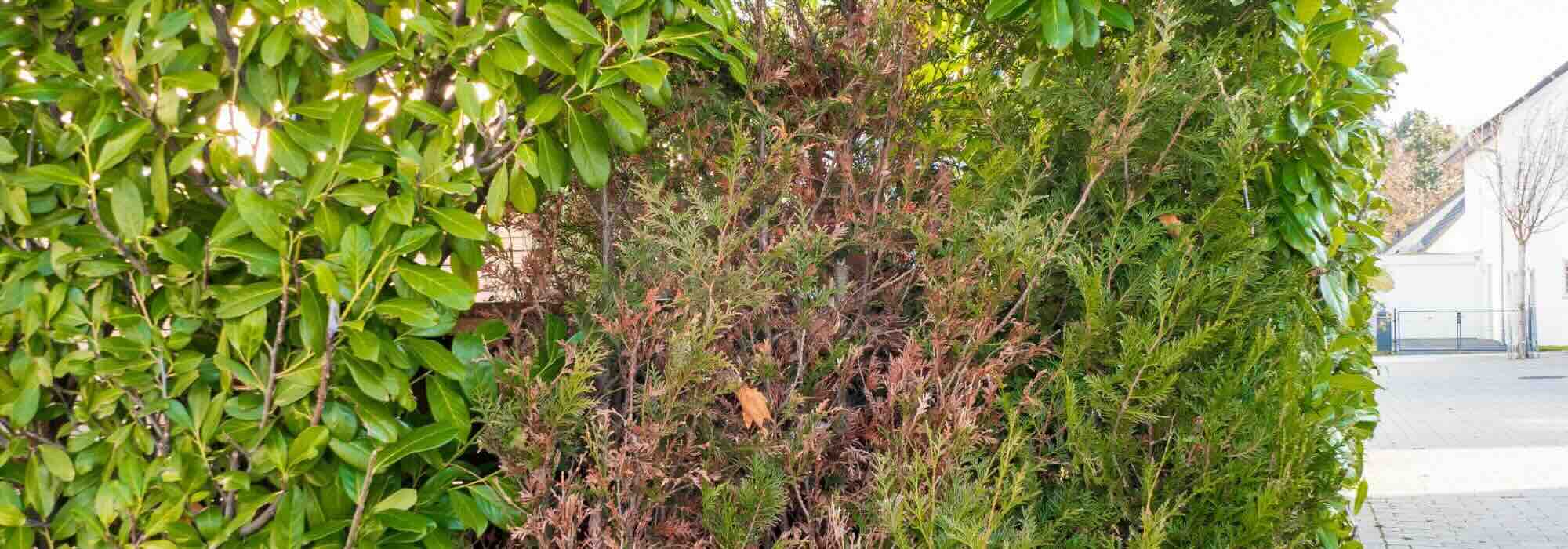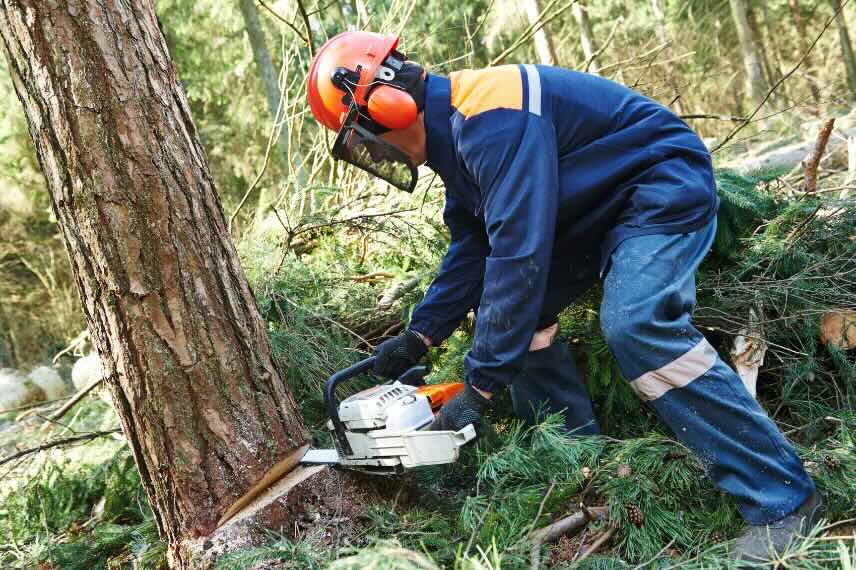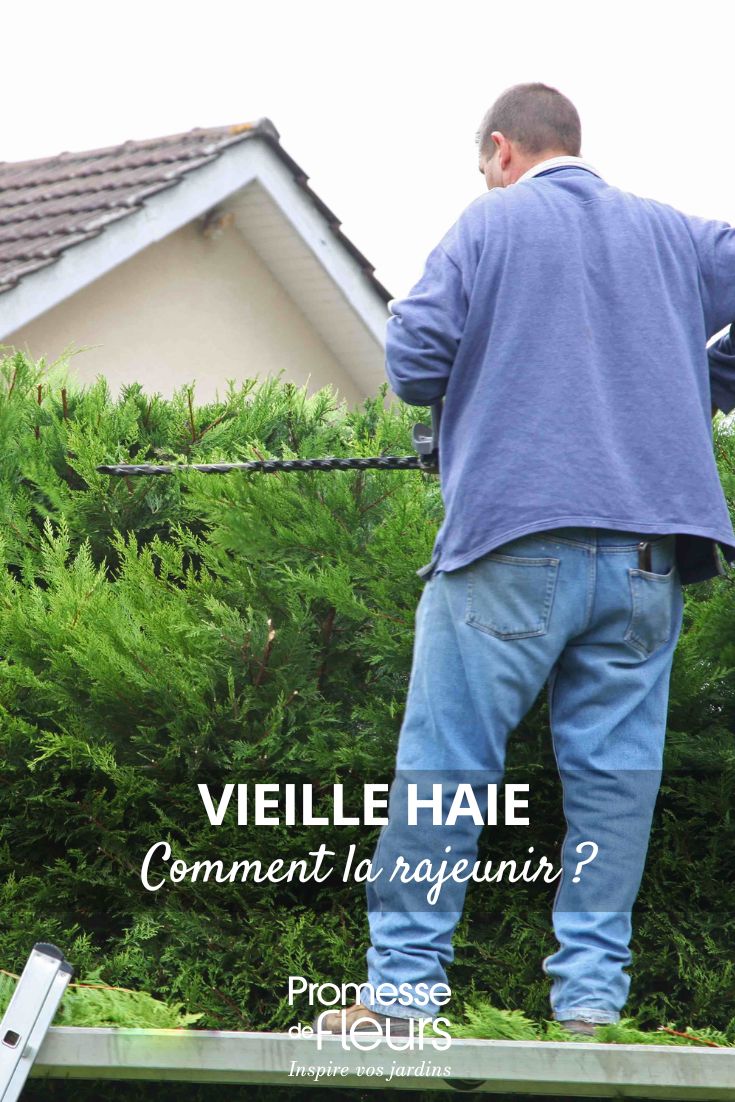
How to rejuvenate an old hedge?
Pruning advice, filling gaps and maintenance tips
Contents
An old hedge can lose its splendour over time. Bare at the base, less dense… the hedge originally planted to shield from prying eyes, to break the wind or for its aesthetic appeal may no longer truly serve its purpose.
But it is entirely possible to rejuvenate an ageing hedge: in fact, it’s a more economical solution than removing it entirely and starting from scratch with a new planting. Discover here the steps to follow to give your garden hedge a second lease of life!
Why does my hedge become less attractive over the years?
Several factors can explain why a garden hedge may become less attractive:
- lack of regular maintenance;
- unsuitable orientation (too much shade due to tree growth or new construction, or conversely, too much sun);
- prolonged drought, particularly during the heatwaves we are experiencing more frequently;
- weather damage (lightning, storms, frost, heavy rainfall…);
- a parasitic infestation;
- the development of diseases.
But it’s not inevitable: action can be taken regardless of the cause to restore a beautiful hedge.

Read also
How to plant a hedge?Preparing the site
In autumn, when the garden begins to prepare for its winter rest, start by observing carefully. If a fence was installed along the hedge, now is also the time to remove it to facilitate future work.
Next, it’s essential to identify:
- plants that are truly dead (they haven’t produced new shoots during the year) or those that are too damaged (split, diseased…);
- suckers or self-sown seedlings that have produced new young plants worth keeping.
You can already remove dead and damaged wood, to better visualise areas requiring drastic pruning, as well as those needing replanting.
Of course, always consider regulations: if it’s a boundary hedge, discuss it with your neighbours before starting any restoration work. Feel free to read our article on the subject: “Hedge Pruning: What Does the Law Say?”
Coppicing to Rejuvenate a Hedge
Stooling is a technique that involves cutting a tree or bush close to the ground, near the collar (the junction between the above-ground and underground root parts). Typically, only 10 to 15 cm in height is retained for a bush and 30 cm for a tree. This drastic pruning is often a last-resort measure for certain plants. Under favourable conditions, it stimulates the production of new shoots or suckers that will generate fresh growth near the stump. It is performed on older, severely damaged, or sparse specimens.
However, be aware: stooling can only be carried out on certain trees and bushes, such as willows, coloured-wood dogwoods, hornbeams, birches, lindens, eucalyptuses, mimosas, forsythias, lilacs, butterfly bushes, photinias, or spindle trees. Note that flowering bushes will not produce flower buds in the year of pruning: you’ll need to wait until the following year to enjoy them again.
On the other hand, conifers (cypresses, thujas…) or fruit trees (plum, cherry, peach…) do not regrow well from the base or cannot withstand such drastic pruning.
Stooling is performed during the plant’s dormancy period, either in winter or very early spring in cooler regions. Always carry it out when there is no risk of frost.
To stool a hedge, first equip yourself with protective clothing: gloves, goggles, cut-resistant fabrics. Next, you’ll need a suitable cutting tool, such as pruning shears, loppers, shears, a pruning saw, or a chainsaw (depending on branch thickness). Remember to disinfect tools between each pruning to prevent disease transmission. Make angled cuts to prevent water from pooling on wounds, which could encourage disease. You may also apply pruning sealant after cutting.
To learn more about this technique, read our article “Stooling Trees and Bushes“.

Even if you’re not cutting a tree, proper protective gear is essential!
Read also
How and why to create a windbreak hedge?Lighter pruning of an ageing hedge
If your hedge does not suffer from significant loss of density at its base, you can opt for less drastic pruning. This will help restore volume to the hedge by encouraging branching in the higher aerial parts.
For this task, once again, equip yourself with pruning shears, shears, or loppers, depending on the thickness of the branches to be shortened.
Prune each bush by about one-third of its height, making sure to cut each branch at an angle, just below an eye (dormant bud). This technique also helps rebalance the shape of trees and bushes to restore a more harmonious hedge.
If your hedge was planted in multiple ranks (in straight lines or staggered) and you wish to maintain its function as a windbreak or privacy screen, you can proceed in two stages. First, begin in the first year by pruning the plants in the front rank. Those in the second rank will continue to provide height for the rest of the year. Then, prune the second rank in late winter or early spring of the following year. By then, the first rank will have had time to produce new branches and thicken, ensuring your hedge never becomes too sparse or low.
Filling in an old hedge
An ageing hedge will often become more sparse and less dense. Some bushes or trees may have died, leaving gaps in the hedge.
To replenish it, you’ll have two options:
- Plant new bushes. However, it may be necessary to first remove the stumps of old plantings.
- Try hedge-laying (pleaching). This technique involves bending or laying bush stems horizontally to fill gaps in a hedge and recreate a green screen. This works with trees or bushes with very flexible branches, such as willows. Train them along stakes left in place for 1-2 years while new shoots develop.
If you choose to plant new specimens, we recommend opting for mixed hedges, combining several different essential oils rather than just one. This limits disease spread and benefits biodiversity. Select them according to your growing conditions (climate, soil type, exposure…) and the type of hedge you wish to recreate:
- Year-round screening hedge or just spring to autumn;
- Windbreak hedge;
- Flowering hedge;
- Fruit hedge;
- Bocage hedge;
- etc.
Among the most popular, easy-care and resilient hedging bushes are cotoneaster, laurustinus, Mexican orange blossom, viburnum, bamboos, dogwood, mahonia or photinia. Consider climbing plants too – they grow quickly and integrate well into hedges, like ivy, honeysuckle or star jasmine.
Budget tip: choose bare-root bushes which are cheaper than container-grown ones.

Consider climbers to replenish a hedge – here a honeysuckle (Lonicera periclymenum) in a hornbeam hedge
Garden hedge maintenance
After pruning, don’t hesitate to provide nutrients to the plants in your hedge to help them get off to a good start. For example, add well-decomposed compost, ground horn or dried blood.
For the first few months, make sure to hoe regularly to eliminate competition from adventives (“weeds”).
If your garden is prone to visits from wild animals (deer, wild boar, rabbits…), consider protecting your young bushes and new shoots by installing wire mesh all around.
For the first two years, it will be important to water your hedge bushes regularly during prolonged dry spells, even the less thirsty ones. They will need some time to develop their root system sufficiently to become resistant to water shortages.
Then, mulch your hedge to reduce evaporation and retain moisture around their base for longer. Use wood chips, vegetable chippings or straw. Mulching also helps limit the growth of adventives and thus reduces the chore of weeding.
Finally, light pruning every year or every other year will help maintain harmonious shapes and densify the foliage of your hedge bushes.
Have you rejuvenated your hedge? Share your experience with us in the comments!
- Subscribe!
- Contents
































Comments